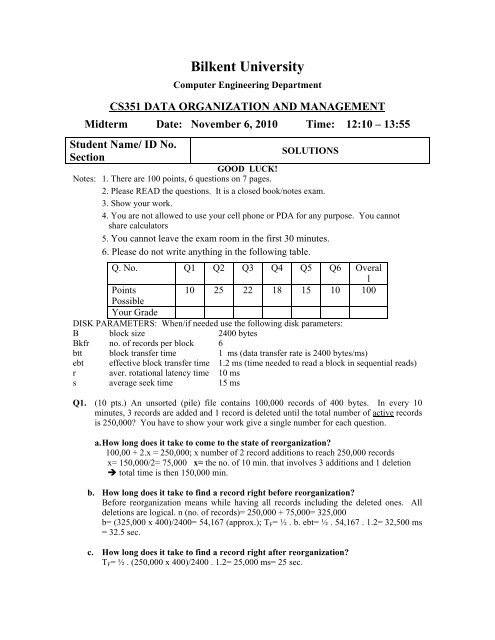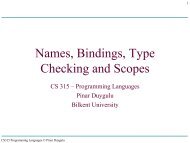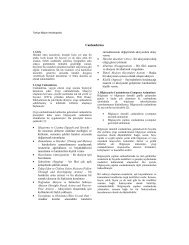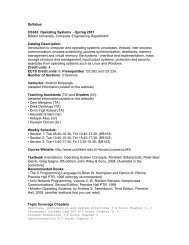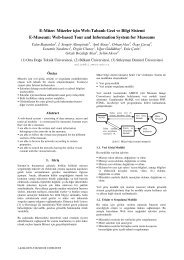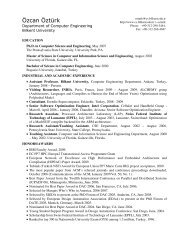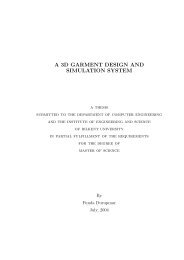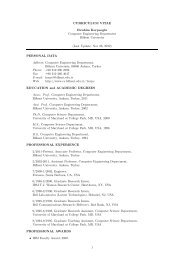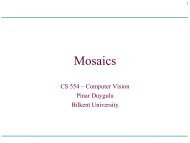questions/solutions - Bilkent University
questions/solutions - Bilkent University
questions/solutions - Bilkent University
Create successful ePaper yourself
Turn your PDF publications into a flip-book with our unique Google optimized e-Paper software.
<strong>Bilkent</strong> <strong>University</strong><br />
Computer Engineering Department<br />
CS351 DATA ORGANIZATION AND MANAGEMENT<br />
Midterm Date: November 6, 2010 Time: 12:10 – 13:55<br />
Student Name/ ID No.<br />
SOLUTIONS<br />
Section<br />
GOOD LUCK!<br />
Notes: 1. There are 100 points, 6 <strong>questions</strong> on 7 pages.<br />
2. Please READ the <strong>questions</strong>. It is a closed book/notes exam.<br />
3. Show your work.<br />
4. You are not allowed to use your cell phone or PDA for any purpose. You cannot<br />
share calculators<br />
5. You cannot leave the exam room in the first 30 minutes.<br />
6. Please do not write anything in the following table.<br />
Q. No. Q1 Q2 Q3 Q4 Q5 Q6 Overal<br />
l<br />
Points<br />
10 25 22 18 15 10 100<br />
Possible<br />
Your Grade<br />
DISK PARAMETERS: When/if needed use the following disk parameters:<br />
B block size 2400 bytes<br />
Bkfr no. of records per block 6<br />
btt block transfer time 1 ms (data transfer rate is 2400 bytes/ms)<br />
ebt effective block transfer time 1.2 ms (time needed to read a block in sequential reads)<br />
r aver. rotational latency time 10 ms<br />
s average seek time 15 ms<br />
Q1. (10 pts.) An unsorted (pile) file contains 100,000 records of 400 bytes. In every 10<br />
minutes, 3 records are added and 1 record is deleted until the total number of active records<br />
is 250,000? You have to show your work give a single number for each question.<br />
a. How long does it take to come to the state of reorganization?<br />
100,00 + 2.x = 250,000; x number of 2 record additions to reach 250,000 records<br />
x= 150,000/2= 75,000 x= the no. of 10 min. that involves 3 additions and 1 deletion<br />
total time is then 150,000 min.<br />
b. How long does it take to find a record right before reorganization?<br />
Before reorganization means while having all records including the deleted ones. All<br />
deletions are logical. n (no. of records)= 250,000 + 75,000= 325,000<br />
b= (325,000 x 400)/2400= 54,167 (approx.); TF= ½ . b. ebt= ½ . 54,167 . 1.2= 32,500 ms<br />
= 32.5 sec.<br />
c. How long does it take to find a record right after reorganization?<br />
TF= ½ . (250,000 x 400)/2400 . 1.2= 25,000 ms= 25 sec.
CS 351: Data Organization and Management, Fall 2010, Midterm p. 2<br />
Q2. (25 pts.) Consider a file with size 650 MB, record size 480 bytes. Each bucket contains<br />
only one block. Assume that 5 MB of memory is available for sorting and merging. For<br />
sorting we want to use heap sort and for merging we want to use 3-way merge. For the file<br />
and sorting conditions please answer the following <strong>questions</strong>.<br />
a. (2 pts) How much time is needed for sorting (i.e., time needed to generate the sorted<br />
segments)?<br />
T = 2 * b * ebt → we need to calculate b<br />
b = file size / Block size = 650 * 10 6 bytes / 2400 bytes = 270,833.33<br />
(Note that we accepted also the following b value<br />
b = file size / record size * bkfr = 650 * 10 6 bytes / 480 bytes * 6 )<br />
⇒ T = 2 * b * ebt = 2 * 270,833.33 * 1,2 ms = 650,000 ms = 650 s<br />
b. (2 pts) How many sorted segments are there after sorting and what cen be said<br />
about the size of sorted segments?<br />
# of segments = file size / MM size = 650 MB / 5 MB = 130<br />
We have 130 sorted segments, each of which is 5 MB.<br />
c. (5 pts) During merging how many passes are required? Draw a table that shows the<br />
merge pass number, number of segments and the size of each segment?<br />
# of passes = ⎡log3 130⎤ = 5<br />
Pass # 1 2 3 4 5<br />
# of sorted<br />
segments<br />
130 44 15 5 2<br />
Size of each<br />
segment<br />
(MB)<br />
130 * 5 MB<br />
43 * 15 MB<br />
1 * 5 MB<br />
14 * 45 MB<br />
1 * 20 MB<br />
4 * 135 MB<br />
1 * 110 MB<br />
1 * 405 MB<br />
1 * 245 MB<br />
d. (3 pts) How much time is required for one pass during merging excluding (s+r)?<br />
T = 2 * b * ebt = 2 * 270,833.33 * 1,2 ms = 650,000 ms = 650 s<br />
(the same T value in part a)
CS 351: Data Organization and Management, Fall 2010, Midterm p. 3<br />
e. (3 pts) How many (s+r) operations are needed for one pass of merge?<br />
2 * p * nsg = 2 * 3 * 130 = 780 (s+r) operations needed<br />
f. (4 pts) How many physical and logical I/O is performed during one pass of merging?<br />
The number of physical I/O is the number of blocks that is read and written.<br />
→ # of phys I/O = 2 * b = 2 * 270,833.33 = 541,666.66<br />
The number of logical I/O is the total number of records that is read and written in each<br />
block.<br />
→ # of logical I/O = bkfr * 2 * b<br />
= (block size / record size) * 2 * b<br />
= (2400 bytes / 480 bytes) * 2 * 270,833.33<br />
= 5 * 2 * 270,833.33<br />
= 2,708,333.3<br />
g. (6 pts) Now assume that we double the bucket size. Give the time needed for one<br />
pass of merging without considering (s+r) and also state the number of physical I/O<br />
and logical I/O.<br />
Doubling the bucket size does not change the time needed for one pass of merging,<br />
therefore, it remains the same.<br />
The number of physical I/O is reduced by half of the number of old physical I/O<br />
→ # of phys I/O = old phys I/O / 2 = 541,666.66 / 2 = 270,833.33<br />
The number of logical I/O also remains the same.
CS 351: Data Organization and Management, Fall 2010, Midterm p. 4<br />
Q3. (22 pts.) Consider a linear hashing file environment. The file contains 386 primary area<br />
disk blocks. The boundary value is equal to 130. The current load factor of the file is 2/3.<br />
The desired load factor of the file is also 2/3. The blocking factor is 12. The following hash<br />
function is used to distribute the records among the blocks: Mod (key, 7500)<br />
a. How many bits do we need to use to find the location of a record in this file?<br />
h = ⌊log (number of primary disk blocks)⌋ = ⌊log (386)⌋ = 8<br />
If record’s last h bits are less than bv, then we look at last (h-1) = 9 bits.<br />
Otherwise, look at h = 8 bits.<br />
b. How many disk blocks are at the hashing level h?<br />
Blocks at level h are placed between bv and 2 h -1: [bv, 2 h -1]<br />
Then; [130, 2 8 - 1] = [130, 255] = 255-130+1 = 126 blocks<br />
c. How many disk blocks are at the hashing level h+1?<br />
(Number of blocks at level h+1)<br />
= (Total number of blocks) – (Number of blocks at level h)<br />
= 386 – 126 = 260 blocks<br />
or<br />
2 * bv = 2 * 130 = 260 blocks<br />
d. How many records are stored in the file?<br />
Lf = (Number of records in file) / (Number of record positions in prime area)<br />
=> (Number of records in file) = Lf * (Number of record positions in prime area)<br />
(Number of records in file) = 2/3 * (386 * 12)<br />
= 3088 records<br />
e. What can be said about the number of overflow blocks?<br />
We can not state anything on the number of overflow blocks.<br />
f. Assume that we want to insert a record with a key value equal to 150880. In which<br />
block are we going to try to insert this record? Express the block number in binary<br />
form and show your work.<br />
Hash function: Mod( record, 7500)<br />
Mod( 150880, 7500) = 880 is 1101110000 in binary.<br />
Look at last h=8 bits and compare with bv: (01110000=112) < 130<br />
which means use (h+1)=9 bits. Insert into block number: 101110000<br />
g. Now assume that 20 records are inserted to the file. What are the new values for h<br />
and bv? Explain your answer.<br />
We know that we expand for each (Lf * Bkfr) = (2/3 * 12) = 8 records inserted.<br />
20 records = 8 + 8 + 4<br />
which means 2 times we expand; then bv becomes 130 + 2 = 132<br />
h does not change.
CS 351: Data Organization and Management, Fall 2010, Midterm p. 5<br />
Q4. (18 pts.) Consider a replacement selection sort environment. Assume that we have a seven<br />
record memory capacity (i.e., total number of records that we can keep in the memory is<br />
seven records). So far the memory contains only one heap and its array representation is as<br />
follows.<br />
10 20 30 25 22<br />
a. Draw the corresponding tree representation.<br />
b. We want to use the above heap structure continue with replacement selection sort using<br />
the records with the following key values 15, 38, 5, and 8. Show the contents of the<br />
heap tree structure(s) as we continue with the sorting process.<br />
10<br />
10<br />
add 15 add 38 output 10<br />
25<br />
add 5<br />
15<br />
20<br />
15<br />
25 22 30<br />
20<br />
5<br />
output 15 output 20<br />
22<br />
25 38<br />
10<br />
20 30<br />
25 22<br />
25<br />
output 22<br />
30 5<br />
38 5<br />
5 8<br />
output 25 output 30 output 38 output 5 output 8<br />
38<br />
8<br />
30<br />
8<br />
c. Give the contents of the output segments: and <br />
8<br />
38<br />
22<br />
25<br />
30<br />
22<br />
8<br />
38<br />
30<br />
8<br />
25<br />
5<br />
38<br />
20<br />
22<br />
15<br />
25<br />
30<br />
30<br />
38<br />
8<br />
5<br />
5
1<br />
0<br />
1<br />
2<br />
00<br />
01<br />
10<br />
11<br />
CS 351: Data Organization and Management, Fall 2010, Midterm p. 6<br />
Q5. (15 %) Insert the records with the keys 7 11 9 20 6 12 5 15 into a hash file in the<br />
order given using extendible hashing. Use h(k)= key mod 11. Block size is 2 records. Show<br />
your steps.<br />
Use prefix!<br />
Insert 7, 11<br />
0<br />
Insert 9, 20<br />
Insert 6<br />
7<br />
11<br />
9<br />
20<br />
2<br />
11<br />
2<br />
7<br />
6<br />
1<br />
9<br />
20<br />
7<br />
11<br />
0000<br />
0111<br />
0110<br />
1001<br />
1001<br />
0111<br />
0000<br />
0111<br />
0000<br />
1001<br />
1001<br />
Key Mod(Key,11) Bin<br />
7 7 0111<br />
11 0 0000<br />
9 9 1001<br />
20 9 1001<br />
6 6 0110<br />
12 1 0001<br />
5 5 0101<br />
15 4 0100
CS 351: Data Organization and Management, Fall 2010, Midterm p. 7<br />
Insert 12<br />
3 12<br />
00<br />
01<br />
10<br />
11<br />
Insert 5 Insert 15<br />
3<br />
000<br />
001<br />
010<br />
011<br />
100<br />
101<br />
110<br />
111<br />
2<br />
11<br />
2<br />
7<br />
6<br />
1<br />
9<br />
20<br />
0000<br />
0001<br />
0111<br />
0110<br />
1001<br />
1001<br />
2<br />
11<br />
12<br />
3<br />
5<br />
3<br />
7<br />
6<br />
1<br />
9<br />
20<br />
0000<br />
0001<br />
0101<br />
0111<br />
0110<br />
1001<br />
0110<br />
3<br />
000<br />
001<br />
010<br />
011<br />
100<br />
101<br />
110<br />
111<br />
2<br />
11<br />
12<br />
3<br />
5<br />
15<br />
3<br />
7<br />
6<br />
1<br />
9<br />
20<br />
0000<br />
0001<br />
0101<br />
0100<br />
0111<br />
0110<br />
1001<br />
0110
CS 351: Data Organization and Management, Fall 2010, Midterm p. 8<br />
Q6. (10 %) Consider a hard disk unit with the revolution speed of 7200 rpm. The disk contains 5<br />
plates where both surfaces of each plate can contain information. Each surface contains 500<br />
tracks and each track contains 100 blocks. The block size is 2400 bytes.<br />
a. Calculate the rotational latency?<br />
60,000 / 7200= 8.33 ms r= 4.17 ms (approximate values)<br />
b. What is the number of cylinders?<br />
Assuming that we have one read/write head per surface it is equal to no. of tracks per surface<br />
and hence it is equal to 500.<br />
c. How many blocks do we have in a cylinder?<br />
No. of tracks per cylinder= total no. of magnetizable surfaces, hence there are 10 tracks per<br />
cylinder and remember that each track contains 100 blocks 1,000 blocks/cylinder.<br />
d. What is the approximate block transfer time?<br />
One full revolution requires about 8.33 ms and there are 100 blcoks per track and hence it is<br />
approximately equal to 8.33 / 100= 0.0833 ms.


